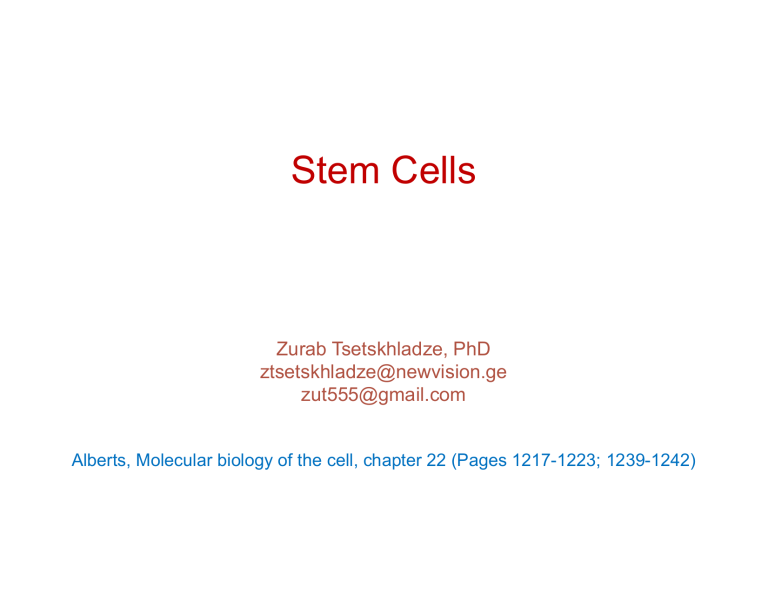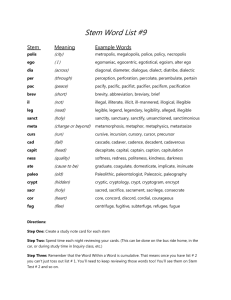
Stem Cells Zurab Tsetskhladze, PhD ztsetskhladze@newvision.ge zut555@gmail.com Alberts, Molecular biology of the cell, chapter 22 (Pages 1217-1223; 1239-1242) • There are more than 200 different named cell types in the human body that collaborate with one another to form many different tissues, arranged into organs performing widely varied functions • Adult body is not static: it is a structure in dynamic equilibrium, where new cells are continually being born, differentiating, and dying • Stem cells are specialized to provide a fresh supply of differentiated cells where these need to be continually replaced, or when they are required in great number for purposes of repair and regeneration The lining of the Small intestine is Continually Renewed There are four main types of non-dividing differentiated cells—one absorptive and three secretory: 1. Absorptive cells (also called brush-border cells or enterocytes) have densely packed microvilli on their exposed surfaces. Their job is to take up nutrients from the gut lumen. They are the majority cell type in the epithelium 2. Goblet cells secrete mucus into the gut lumen that covers the epithelium with a protective coat 3. Paneth cells form part of the innate immune defense system and secrete proteins that kill bacteria 4. Enteroendocrine cells, of more than 15 different subtypes, secrete serotonin and peptide hormones that act on neurons and other cell types in the gut wall and regulate the growth, proliferation, and digestive activities of cells of the gut and other tissues. The four main differentiated cell types found in the epithelial lining of the small intestine The central problem is to understand the processes in the crypt that generate a continual supply of all these nondividing, terminally differentiated cell types. Stem Cells of the Small intestine lie at or near the base of each Crypt • The general pattern of cell proliferation and migration in the gut lining is revealed by a simple labeling method that uses injected pulses of tritiated (radioactive) thymidine or of a thymidine analog that can be detected in tissue sections • Cells that are in S phase of the division cycle incorporate the marker molecule into their DNA, and their fate can then be followed over subsequent hours and days • If a cell divides after incorporation of the label, the label becomes diluted, halving with each cell cycle. This can be quantified Stem cells are of many types, specialized for the genesis of different classes of terminally differentiated cells: • intestinal stem cells for intestinal epithelium • epidermal stem cells for epidermis • hematopoietic stem cells for blood and so on Where are the stem cells that renew the epithelium of the gut found? a. in the bone marrow b. in the inner cell mass c. in the villi, underlying the dead outer layer of keratinocytes d. in the connective tissue underlying the gut epithelium e. near the bottom of the crypt What are the distinguishing features of the stem cell in molecular terms? What conditions serve to keep the stem cell in its proper place and to maintain its stem-cell character? What decides whether a given daughter cell commits to differentiation or remains a stem cell? The Wnt/β-catenin signaling pathway Wnt proteins are secreted signal molecules that act as local mediators and morphogens to control many aspects of development in all animals that have been studied. They were discovered independently in flies and in mice: in Drosophila, the Wingless (Wg) gene originally came to light because of its role as a morphogen in wing development, while in mice, the Int1 gene was found because it promoted the development of breast tumors when activated by the integration of a virus next to it. Both of these genes encode Wnt proteins. Two scaffold proteins called axin and Adenomatous polyposis coli (APC) hold the protein complex together Wnt Signaling maintains the Gut Stem-Cell Compartment Apc (adenomatous polyposis coli) codes for a protein that prevents inappropriate activation of the Wnt signaling pathway An adenoma* in the human colon, compared with normal tissue from an adjacent region of the same person’s colon. the specimen is from a patient with an inherited mutation in one of his two copies of the Apc gene. A mutation in the other Apc gene copy, occurring in a colon epithelial cell In a tissue where several distinct types of differentiated cells must be produced, are they all derivedduring from aadult singlelife, has given rise to a clone type of stem cell, or is there a distinct type of of stem cells cell thatfor behave as though the wnt each one? signaling pathway is permanently activated. as a result, the cells of this clone form an adenoma—an enormous, steadily expanding mass of giant cryptlike structures. *adenomas - precancerous tumors Because Apc codes for a protein that prevents inappropriate activation of the Wnt signaling pathway, this loss of Apc is presumed to mimic the effect of continual exposure to a Wnt signal. The suggestion, therefore, is that Wnt signaling normally keeps crypt cells in a proliferative state, and that a cessation of exposure to Wnt signaling normally makes them stop dividing as they leave the crypt. In a tissue where several distinct types of differentiated cells must be produced, are they all derived from a single type of stem cell, or is there a distinct type of stem cell for each one? Green Fluorescent Protein (GFP) • Green fluorescent protein (GFP), isolated from the jellyfish Aequorea Victoria • This protein is encoded by a single gene, which can be cloned and introduced into cells of other species • The freshly translated protein is not fluorescent, but within an hour or so (less for some alleles of the gene, more for others) it undergoes a self-catalyzed posttranslational modification to generate an efficient fluorochrome, shielded within the interior of a barrel-like protein, which will now fluoresce when illuminated appropriately with blue light • One of the simplest uses of GFP is as a reporter molecule, a fluorescent probe to monitor gene expression. A transgenic organism can be made with the GFP coding sequence placed under the transcriptional control of the promoter belonging to a gene of interest, giving a directly visible readout of the gene’s expression pattern in the living organism • In another application, a peptide location signal can be added to the GFP to direct it to a particular cell compartment, such as the endoplasmic reticulum or a mitochondrion, lighting up these organelles so they can be observed in the living state. Green fluorescent protein (GFP) Stem Cells at the Crypt base are multipotent, Giving Rise to the Full Range of differentiated intestinal Cell types • • A search among genes that are strongly upregulated in response to Wnt signaling revealed one, called Lgr5, that is expressed in gut stem cells specifically LacZ gene encodes β-galactosidase, an enzyme that can be detected histochemically in tissues The process of cell specialization is also called ____. A. B. C. D. Specification Stratification Diffraction Differentiation the two daughters of a Stem Cell do not always have to become different A Single Lgr5-expressing Cell in Culture Can Generate an entire organized Crypt-villus System Tissue Renewal that does not depend on Stem Cells: insulin Secreting Cells in the pancreas and hepatocytes in the liver Some types of cells can divide even though fully differentiated, allowing for renewal and regeneration without the use of stem cells • The insulin-secreting cells (β cells) of the pancreas are one example • Another tissue that can renew by simple duplication of fully differentiated cells is the liver. If two-thirds of a rat’s liver is removed, for example, a liver of nearly normal size can regenerate from the remainder by hepatocyte proliferation within about two weeks • Both the pancreas and the liver contain small populations of stem cells that can be called into play as a backup mechanism for production of the differentiated cell types in more extreme circumstances. This imparts resilience to the mechanisms of renewal and repair Stem Cells And Differentiation A Hierarchical Stem-cell System: Blood Cell Formation A tentative scheme of hematopoiesis Rescue of an irradiated mouse by a transfusion of bone marrow cells



